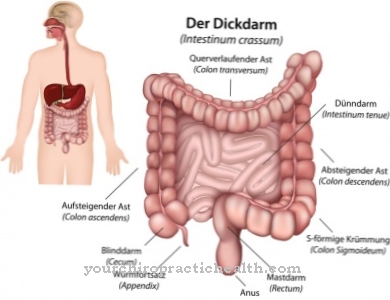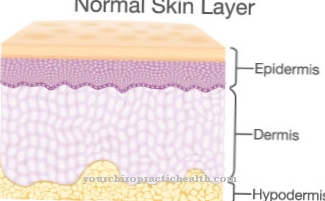With the term acute transient erythroblastopenia a temporary poverty of erythroblasts, the precursor cells of the erythrocytes, is called. The disease leads to temporary anemia for reasons that are often unknown, because the process of red blood cell formation (erythropoiesis) from bone marrow stem cells is temporarily slowed down or interrupted. In infants and young children, it is the most common form of anemia that is not due to abnormal red blood cells.
What is acute transient red cell aplasia?

Acute transient erythroblastopenia is a temporary reduced concentration of erythroblasts. Erythroblasts arise from cell division and differentiation from macroblasts within erythropoiesis. Erythropoiesis is the overall process of the formation of red blood cells (erythrocytes) from multipotent stem cells in the bone marrow.
The reduced number of erythroblasts leads to anemia, which is due solely to an insufficient number of erythrocytes, but not to iron deficiency or erythrocytes with deficiencies. Transient red cell aplasia causes the form of anemia, which is the most common form of normocytic anemia in young children and infants.
In this context, normocytic means that the erythrocytes present have a normal size and normal functionality. What is essential in the transient form of erythroblastopenia is its temporary appearance. The interruption or inhibition of erythropoiesis usually lasts about one to two weeks. Then there is a spontaneous recovery of the erythropoiesis with regeneration and resolution of the anemic state.
causes
Often, a diagnosed acute transient red cell aplasia is labeled idiopathic, indicating that the causes that triggered the disease are unknown. It seems certain that certain substances lead to a temporary interruption of erythropoiesis lasting around one to two weeks. Certain drugs and viral infections can cause acute transient erythroblastopenia.
For example, some authors associate the causative agent of rubella, the parvovirus B19, with transient erythroblastopenia. Rubella is one of the classic childhood diseases and is usually harmless. Chronic hemolysis, in which the cell membrane of erythrocytes is continuously dissolved and the hemoglobin is transferred to the plasma, is also considered to be a possible cause of acute transient erythroblastopenia.
Symptoms, ailments & signs
The first signs and symptoms of acute transient erythroblastopenia are quite unspecific and very similar to anemia acquired for other reasons. Noticeable are a translucent pallor of the skin, a rapid onset of fatigue and a general reduction in performance. The general symptoms are usually accompanied by a headache.
The symptoms can ultimately be traced back to a reduced supply of oxygen and nutrients to the brain, muscle tissue and other tissues that require oxygen.With a pronounced course of the disease, breathing is also difficult (dyspnea) and an accelerated pulse (tachycardia). The acute transient red cell aplasia shows no signs of inflammation. For example, neither the spleen, liver nor lymph nodes are swollen, which could otherwise indicate an inflammatory reaction.
Diagnosis & course
In addition to the unspecific symptoms and signs of acute transient erythroblastopenia described above, an examination of the blood count ensures a clear diagnosis. A normocytic anemia is shown, which means that the size of the erythrocytes present is within the tolerable range, i.e. they do not show any abnormalities. What is noticeable, however, is the reduced number of reticulocytes, which represent the young, not yet fully differentiated, erythrocytes within the chain of erythropoiesis.
In some cases, myelopoiesis is also impaired, the process that affects the formation of various white blood cells such as granulocytes, monocytes and platelets in the bone marrow in addition to erythropoiesis. This means that the blood count can also show a reduced number of neutrophils, for example.
The course of the disease is usually self-regulating. Normally, the erythropoiesis regenerates within one to two weeks, so that the symptoms also subside without therapy. If this is not the case, an incorrect diagnosis has been made.
Complications
Acute transient red cell aplasia is understood to be a temporary containment of red blood cell formation. This type of anemia is most common in infants and young children. Since the process is inhibited directly within the bone marrow stem cells, those affected should be given medical treatment to be on the safe side.
The cause of the symptom is suspected to be ringworm pathogens, infections, various substances and medications, and chronic hemolysis. These then lead to an interruption in the formation of red blood cells for about five to fourteen days. During this time, the signs can cause some complications for the sufferer.
In addition to the noticeable paleness, there are strong bouts of tiredness with severe headaches and a considerable reduction in performance. If the first characteristics of acute transient red cell aplasia are ignored, this can lead to shortness of breath and a racing heart even at rest. With infants in particular, there is a risk that the poor supply of oxygen and nutrients to the blood, muscle tissue and brain will be undersupplied.
In most cases, the patient regenerates himself with sufficient rest and good nutrition, without the need for medication. If the disease is too advanced, heart failure can develop as a complication risk. In the case of a blood transfusion, as an immediate measure, the person concerned is supplied with enough red blood cells to rule out the risk of cardiovascular failure.
When should you go to the doctor?
If you suspect acute transient erythroblastopenia or a comparable condition, you should see a doctor immediately. If symptoms such as headaches, tiredness and a general reduction in performance are observed, this must be discussed with a doctor. Outwardly, the disease shows up, among other things, by pale skin and dark circles. If one of these symptoms is noticed, go to the doctor and determine the cause.
The symptoms do not necessarily indicate an acute transient erythroblastopenia, but do indicate a condition that should be clarified and treated. If anemia is left untreated, it can lead to shortness of breath or a racing heart. Particularly at risk are infants who should be brought to the pediatrician at the first signs of anemia. Adults should see a doctor if symptoms do not resolve on their own despite adequate rest and eating well. At an advanced stage, cardiovascular complaints can occur, which must always be treated by an emergency doctor.
Doctors & therapists in your area
Treatment & Therapy
Because acute transient red cell aplasia is usually temporary, in many cases no therapy is required. The spontaneous regeneration of erythropoiesis can be supported and accelerated by taking erythropoietin, iron and folic acid. The polypeptide erythropoietin, which is composed of 165 amino acids, is a glycoprotein hormone and belongs to the group of cytokines.
The hormone controls the process of erythropoiesis. Erythropoietin is also known as a doping agent under the infamous name EPO. There is only a need for immediate action in the case of a serious illness with a risk of heart failure and cardiogenic shock.
Due to the lack of differentiated erythrocytes, which cannot easily be remedied by medication or other measures, the most effective treatment option in these cases remains a blood transfusion, which at least temporarily provides the necessary supply of erythrocytes.
Outlook & forecast
In most cases, transient erythroblastopenia leads directly to anemia in the patient. The person concerned appears tired and exhausted and no longer actively participates in life. There is a severe headache that can spread to other areas of the body. If the pain also occurs at night, the transient erythroblastopenia can lead to sleep disorders.
As a rule, there is also a reduced supply of oxygen, so that the extremities and organs are undersupplied. In the worst case, it can lead to the death of individual organs or extremities, which can sometimes lead to death. Infections can also occur in the liver or spleen.
The quality of life of the person affected is extremely reduced by the disease. The resilience also drops enormously, so that the patient can no longer easily carry out normal everyday activities or sporting activities. Treatment takes place with the help of medication and can limit the symptoms. In severe cases, transfusions are necessary. Furthermore, damage to the organs or extremities may need to be treated.
prevention
Since the etiology of acute transient erythroblastopenia is not sufficiently well known, there are no direct preventive measures to counteract the occurrence of the disease. Nor is it known whether certain genetic dispositions are among the risk factors. Since the disease mostly occurs in infants and small children, measures that strengthen the immune system are to be classified as beneficial in terms of preventive measures.
It cannot be said with certainty whether this will effectively prevent the occurrence of the disease. If the transient form of erythroblastopenia is suspected, it is advisable to use differential diagnosis to rule out other diseases that may require immediate treatment.
Aftercare
With this disease, the person affected is primarily dependent on rapid and, above all, early detection and treatment so that further complications or complaints do not occur. The earlier a doctor is consulted, the better the further course of this disease is usually. It cannot be universally predicted whether this disease will lead to a reduced life expectancy for the person affected.
However, there are usually no special measures or options for follow-up care available to the person concerned, and self-healing cannot occur. The focus is therefore on the early detection and treatment of this disease. When treating this disease, the person concerned is primarily dependent on the use of various medications.
It is important to ensure the correct dosage and regular intake in order to counteract the symptoms. Since this disease can also cause various heart problems, regular heart examinations should be performed. The person affected should not put unnecessary strain on their body and should also pay attention to a healthy diet and lifestyle. Under certain circumstances, contact with other people affected by the disease can also be useful.
You can do that yourself
Acute transient red cell aplasia usually does not require special treatment. It affects adults, but primarily young children. In addition to the characteristic paleness, symptoms such as headache, decreased performance and fatigue may occur. Still, a lot can be done to improve wellbeing.
Fresh air, physical restraint and moderate exercise are good for you. However, excessive demands and great effort should be avoided. Parents of affected children can ensure that rest periods are observed. Even affected adults do well to rest. Cold compresses can be offered for headaches, and in more severe cases pain medication prescribed by a doctor. Quiet activities, reading aloud and listening to radio plays are beneficial for the sick child. Adult patients also avoid being overburdened with intense physical activity.
Furthermore, you should pay attention to a healthy diet with fresh fruit, vegetables, meat and fish. The disease regularly improves without further action. However, regular medical check-ups and observation of the symptoms are useful. Even if the disease only requires special medical therapy in exceptional cases, watch out for signs of shock or possible heart failure. If such signs are present, the attending physician should be consulted. Acute transient red cell aplasia usually heals within two weeks.


.jpg)



.jpg)

















.jpg)



